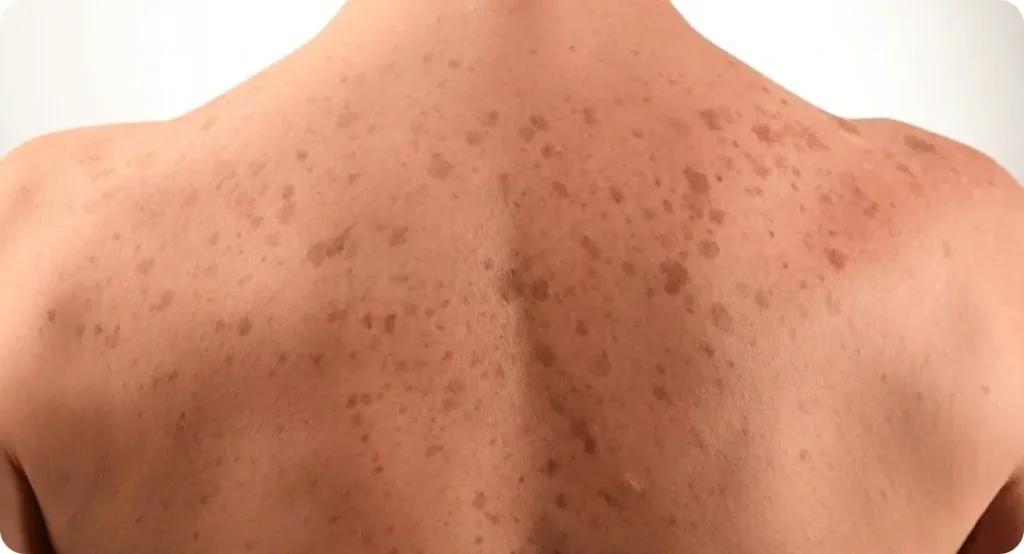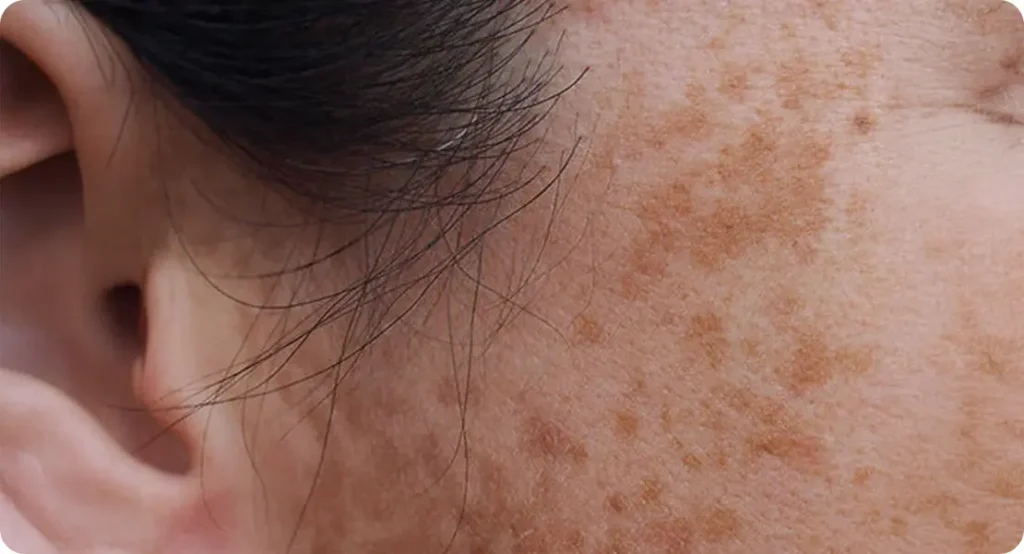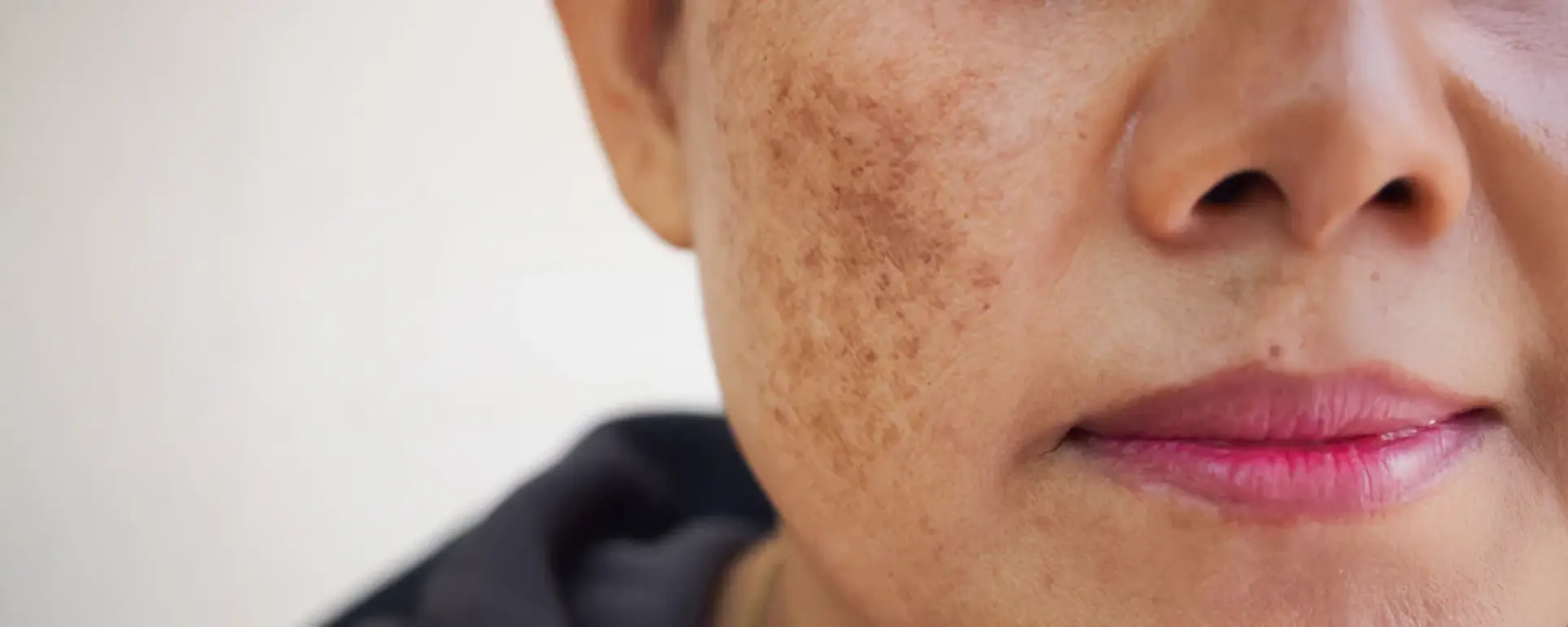You finally did it after weeks, months, or maybe even years of battling breakouts, your acne has cleared up. Your skin is smoother, your pores are calmer, and for the first time in a while, you can look in the mirror without seeing angry red bumps. But just as you’re starting to feel relieved, there’s a new issue staring back at you: dark, stubborn marks that won’t budge.
These lingering spots are known as post-inflammatory hyperpigmentation (PIH), and they’re one of the most common (and most frustrating) after-effects of acne. They usually appear as flat brown, purple, or red patches where a blemish once lived and while they aren’t painful, they can be emotionally draining. Even though your acne is gone, it still looks like you’re dealing with skin problems, and that can chip away at your confidence all over again.
Here’s the thing: PIH is completely normal. It’s your skin’s natural response to inflammation, especially in people with medium to deep skin tones. The pigment-producing cells (called melanocytes) go into overdrive during a breakout, leaving behind discolouration even after the spot has healed. And while these marks can fade on their own, it often takes months or even years for them to disappear without help.
The good news? You don’t have to wait that long. With the right skincare ingredients, smart sun protection, and in some cases, professional treatments, you can significantly speed up the fading process. Whether you’re dealing with a few leftover marks or widespread discolouration, there are ways to restore your skin’s clarity and confidence. Let’s dive into how to do just that.
1. Understand What You’re Dealing With
Before you can treat dark marks effectively, it’s important to understand what they actually are. These patches aren’t permanent scars they’re known as post-inflammatory hyperpigmentation (PIH). PIH occurs when the skin responds to inflammation (like a pimple, rash, or injury) by producing excess melanin, the pigment responsible for skin colour. This overproduction is your body’s natural defence mechanism, but it leaves behind flat spots that are darker than your normal skin tone.
These marks can range in colour depending on your complexion light brown, reddish, purple, or even bluish in some cases. Unlike acne scars, which can involve changes in skin texture like pitting or raised bumps, PIH spots are smooth and sit on the surface of the skin.
The frustrating part? They can linger for a long time. In some cases, PIH can take several months or even years to fully fade, especially if no active steps are taken to treat it. And while anyone can develop PIH, people with medium to deep skin tones are more prone to it because their melanocytes are more reactive. That means even minor inflammation can trigger noticeable pigmentation.
The good news is that PIH is treatable with the right care. But because darker skin tones can also be more sensitive to certain ingredients and procedures, it’s crucial to take a targeted and gentle approach. By understanding the root of the problem, you can make smarter choices that help your skin heal faster and more evenly.
2. Start with Daily SPF (Yes, Really)
If you’re serious about fading dark marks, your first and most important step isn’t a fancy serum or a laser treatment. It’s sunscreen. Yes, really. Many people underestimate just how much sun exposure can affect post-inflammatory hyperpigmentation (PIH), but the truth is: UV rays can make dark spots darker and more stubborn, even if you’re not tanning.
When your skin is exposed to sunlight, it naturally produces more melanin as a protective response. For areas already affected by PIH, this means those spots can become even more pigmented essentially undoing any progress you’re making with your skincare routine. On top of that, unprotected sun exposure can slow down your skin’s natural healing process, keeping those dark marks around longer than necessary.
That’s why sunscreen isn’t optional it’s absolutely essential. Think of it as your skin’s daily shield. Choose a broad-spectrum SPF 30 or higher, which protects against both UVA and UVB rays. And don’t forget to reapply every two hours if you’re spending time outdoors, especially if you’re sweating or swimming.
The good news? Many modern sunscreens now do more than just protect. You’ll find formulas that include brightening ingredients like niacinamide, which helps fade dark spots, or antioxidants like vitamin C and green tea, which protect the skin from environmental damage while improving tone and texture. Some even come with a subtle tint to even out your complexion instantly.
Whether your skin is oily, dry, sensitive, or acne-prone, there’s a sunscreen out there for you. So if you’re not already using SPF every single morning make today the day you start. It might just be the simplest yet most powerful tool in your fight against hyperpigmentation.
3. Use Brightening Ingredients

Once you’ve committed to daily sunscreen, the next step is to introduce targeted brightening ingredients into your skincare routine. These topical heroes work by gently fading post-inflammatory hyperpigmentation (PIH) over time, helping to restore a more even and radiant complexion. While results won’t happen overnight, consistent use combined with sun protection can make a noticeable difference within a few weeks.
Here are some of the most effective ingredients to look for:
- Niacinamide (Vitamin B3): This multitasking ingredient is a favourite for a reason. Niacinamide helps to calm inflammation, regulate oil production, and improve the skin’s barrier function. Most importantly for PIH, it also helps reduce the transfer of melanin to skin cells, leading to a more even skin tone. It’s gentle, non-irritating, and safe for daily use perfect for those with sensitive or acne-prone skin.
- Vitamin C (Ascorbic Acid): A powerful antioxidant, vitamin C helps to neutralise free radicals that can worsen pigmentation. It also inhibits melanin production, which makes it highly effective at fading existing dark spots while preventing new ones. Look for serums with stable forms of vitamin C (like sodium ascorbyl phosphate or ascorbyl glucoside) to avoid oxidation and irritation.
- Azelaic Acid: Derived from grains like barley and rye, azelaic acid is a gentle exfoliator that not only smooths the skin’s surface but also inhibits tyrosinase, the enzyme responsible for melanin production. It’s especially helpful for people dealing with both acne and PIH, as it has antibacterial and anti-inflammatory properties as well.
- Tranexamic Acid: This rising star in the skincare world is known for its ability to target stubborn pigmentation without harsh side effects. It works by disrupting the pathways that lead to excess melanin production, making it ideal for those who want a safe yet powerful solution for dark spots. Tranexamic acid can be found in serums or combined with other brighteners for enhanced results.
When shopping for products, look for serums, moisturisers, or even masks that contain one or more of these ingredients. Serums, in particular, are highly effective because they deliver concentrated active ingredients directly into the skin.
Consistency is key. You’ll need to use these products regularly ideally once or twice daily for at least 8 to 12 weeks to start seeing visible improvements. Be patient and gentle with your skin, and avoid using too many actives at once, especially if you’re just starting out. Overloading your routine can lead to irritation, which might worsen pigmentation rather than improve it.
4. Incorporate Gentle Exfoliation
If you want to fade dark marks faster, gentle exfoliation is a key part of the process. Exfoliating helps remove the buildup of dead skin cells on the surface, which can otherwise make hyperpigmentation look more prominent. More importantly, it encourages cell turnover allowing fresh, evenly toned skin to gradually replace older, pigmented layers.
But here’s the catch: not all exfoliation is created equal. While it might be tempting to grab a gritty face scrub or rough cleansing brush, harsh physical exfoliants can do more harm than good especially if you have sensitive or acne-prone skin. They can cause micro-tears, trigger inflammation, and potentially worsen PIH.
Instead, opt for chemical exfoliants formulas that use active ingredients to dissolve the bonds between dead skin cells rather than scrubbing them off. These tend to be much more effective and skin-friendly when used correctly.
Here are two of the most effective types for fading PIH:
- AHAs (Alpha Hydroxy Acids): Ingredients like glycolic acid and lactic acid fall into this category. AHAs are water-soluble acids that work on the surface of the skin to smooth texture, brighten dullness, and fade discolouration. Glycolic acid is stronger and penetrates deeper, while lactic acid is milder and hydrating great for those with sensitive or dry skin. Look for products with a concentration of 1% to 5% to start, and build up as your skin adjusts.
- BHAs (Beta Hydroxy Acids): The most common BHA is salicylic acid, which is oil-soluble and particularly helpful for those with oily or acne-prone skin. It penetrates into pores to help clear out congestion while also lightly exfoliating the skin’s surface. This makes it a great dual-action ingredient if you’re managing both breakouts and dark marks.
How often should you exfoliate? Start with 2 to 3 times a week either in the morning or evening and observe how your skin responds. Over-exfoliating can strip the skin’s protective barrier, leading to irritation, redness, or even more pigmentation. If you’re already using other actives like retinoids or vitamin C, alternate usage days to prevent sensitivity.
Look for gentle exfoliating toners, serums, or masks and always follow up with moisturiser and sunscreen, as exfoliated skin can be more sensitive to the sun.
5. Avoid Picking or Scratching
It might seem like a small habit, but picking, scratching, or squeezing your skin can seriously sabotage your progress when trying to fade post-inflammatory hyperpigmentation (PIH). As tempting as it is to “help” a blemish along, this kind of interference often causes more harm than good.
When you pick at a spot whether it’s a healing pimple, a scab, or a flake of dry skin you’re creating additional trauma. That trauma leads to increased inflammation, which in turn triggers your skin to produce even more melanin. The result? A darker, longer-lasting mark that takes even more time to fade.
And it’s not just about dark spots. Picking can also lead to textural scarring, infection, or prolonged breakouts, all of which delay your skin’s healing process. What could’ve been a short-lived blemish might turn into a lingering issue that affects both the look and health of your skin.
Here are a few tips to help break the habit:
- Keep your nails short and clean. Long or sharp nails can accidentally scratch or damage skin, even when you don’t realise you’re doing it.
- Use pimple patches. These thin, adhesive patches create a physical barrier between your fingers and your blemish. Many are medicated with ingredients like salicylic acid or tea tree oil, helping to calm inflammation while reducing the urge to touch.
- Wash your hands often. Sometimes just being more aware of what’s on your hands can make you think twice before touching your face.
- Set up distractions. If you tend to pick while watching TV or sitting at your desk, keep your hands busy try a stress ball, fidget spinner, or even wearing soft gloves at night if you’re a sleep-picker.
Remember, hands off = healing faster. Practising restraint and treating your skin with kindness may be the most underrated, yet most effective, part of your skincare routine. Every day you avoid picking is a day closer to clearer, healthier-looking skin.
6. Try Prescription-Grade Treatments
If you’ve been consistent with sunscreen, brightening serums, and gentle exfoliation for several weeks but your dark spots still won’t budge, it might be time to bring in the big guns. Prescription-strength treatments can make a noticeable difference, especially for moderate to severe post-inflammatory hyperpigmentation (PIH) that hasn’t responded well to over-the-counter products.
A consultation with a dermatologist can help you access more potent ingredients that target pigmentation at a deeper level. These aren’t just stronger they’re also often formulated to work more precisely and efficiently. Here are some prescription options worth considering:
- Hydroquinone (2–4%): Often considered the gold standard in skin lightening, hydroquinone works by inhibiting the enzyme tyrosinase, which plays a central role in melanin production. When used correctly, it can dramatically fade hyperpigmentation. However, it must be used under medical supervision, as overuse or incorrect application can cause irritation or rebound pigmentation especially in deeper skin tones. It’s usually prescribed as part of a short-term treatment plan.
- Retinoids (e.g., tretinoin, adapalene): Retinoids are vitamin A derivatives that stimulate cell turnover, boost collagen production, and gradually fade pigment over time. They’re also effective at preventing acne, which makes them a good dual-action option for those dealing with both breakouts and PIH. Prescription-strength retinoids can be more potent than over-the-counter versions, so start slowly and always pair them with moisturiser and SPF to minimise dryness and sensitivity.
- Cysteamine Cream: A relatively newer option in the world of pigmentation treatments, cysteamine is an antioxidant that reduces melanin production with a gentler profile than hydroquinone. Studies show it’s effective for conditions like melasma and PIH, and it’s particularly promising for people with sensitive or darker skin types. It requires daily application, and results can take a few months but it’s a great option for those looking for a non-hydroquinone alternative.
Prescription treatments should always be used under the guidance of a qualified dermatologist, especially if you have sensitive skin or a history of irritation. Your doctor may also suggest combination therapies (such as tretinoin + hydroquinone + corticosteroids) for more comprehensive results.
While these treatments may require a bit more effort, cost, or monitoring, they can provide significant improvements in pigment clarity and overall skin health especially when paired with a solid at-home routine.
7. Explore In-Clinic Procedures

If topical treatments prescription or over-the-counter aren’t giving you the results you hoped for, it might be time to consider professional in-clinic procedures. These treatments are often more intensive and can deliver faster, more noticeable results, especially for stubborn or deep-seated post-inflammatory hyperpigmentation (PIH).
The key? Working with a qualified and experienced dermatologist or licensed skincare professional, particularly one who understands how to treat pigmentation on your specific skin tone and type. Here are a few of the most effective options available:
- Chemical Peels: This treatment involves applying a chemical solution (such as glycolic acid, salicylic acid, or trichloroacetic acid) to exfoliate the top layers of skin. Over time, the old, pigmented skin sheds away, revealing a fresher, more even-toned layer beneath. Light to medium-depth peels are often used for PIH and can be spaced out over several weeks. Peels can also improve overall texture, unclog pores, and even reduce acne.
- Microneedling (Collagen Induction Therapy): In this procedure, tiny needles are used to create controlled micro-injuries in the skin. This triggers the body’s natural healing response, stimulating collagen production and encouraging the formation of new skin cells. Microneedling is particularly effective for both PIH and acne scarring, as it works on texture and tone simultaneously. It also helps skincare products absorb more efficiently post-treatment.
- Laser Therapy: Laser treatments like Q-switched lasers, Nd:YAG, or fractional lasers target excess melanin with precision, breaking down pigment particles so they can be cleared by the body over time. Laser therapy can be highly effective, but it must be chosen carefully especially for deeper skin tones to avoid risks of post-laser hyperpigmentation. When done correctly by a skilled practitioner, lasers can offer fast and dramatic results.
These procedures often work best when combined with a solid at-home skincare routine and multiple sessions spaced out over time. Keep in mind that downtime, cost, and potential side effects vary depending on the treatment. Always go for a thorough consultation beforehand to understand what to expect.
If you’re feeling stuck in your skincare journey, in-clinic treatments might be the boost you need to finally reach your goals and reclaim your glow.
Final Thoughts: Clear Skin Takes Time but It’s Possible
Post-acne dark marks are frustrating but they’re also fixable. With the right mix of consistent skincare and professional help, you can clear the leftover pigmentation and feel more confident in your skin. You can get in touch with us to book a consultation at our acne clinic and get a personalised treatment plan that works.
References:
- Lawrence, E., Syed, H.A. & Al Aboud, K.M., 2024. Postinflammatory Hyperpigmentation. In: StatPearls [Internet]. Treasure Island (FL): StatPearls Publishing; updated 25 November 2024. Available at: https://www.ncbi.nlm.nih.gov/books/NBK559150/
- Pillaiyar, T., Manickam, M. & Namasivayam, V., 2017. Skin‑whitening agents: medicinal chemistry perspective of tyrosinase inhibitors. Journal of Enzyme Inhibition and Medicinal Chemistry, 32(1), pp.403–425. DOI: 10.1080/14756366.2016.1256882. Available at: https://pubmed.ncbi.nlm.nih.gov/28097901/
- Budamakuntla, L., Loganathan, E. & Suresh, D.H., et al., 2013. A Randomised, Open‑label, Comparative Study of Tranexamic Acid Micro‑injections and Tranexamic Acid with Microneedling in Patients with Melasma. Journal of Cutaneous and Aesthetic Surgery, 6(3), pp.139–143. DOI: 10.4103/0974-2077.118403. Available at: https://pubmed.ncbi.nlm.nih.gov/24163529/
- Draelos, Z.D., 2007. Skin lightening preparations and the hydroquinone controversy. Dermatologic Therapy, 20(5), pp.308–313. DOI: 10.1111/j.1529-8019.2007.00144.x. Available at: https://pubmed.ncbi.nlm.nih.gov/18045355/
Chaowattanapanit, S., Periyapat, P. & Taylor, S.C., 2014. Postinflammatory hyperpigmentation: review of pathogenesis. Pigment Cell & Melanoma Research, 27(3), pp.429–435. Available at: https://onlinelibrary.wiley.com/
